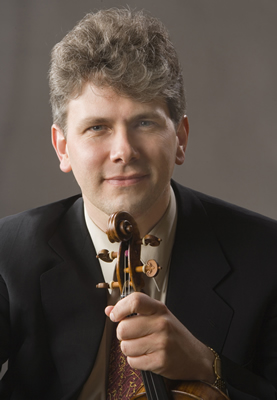St. Stephen’s Episcopal Church‘s five-concert series has become one of the Triangle’s must-attend musical events. There is a “homecoming” quality about the concerts since the church has encouraged so many local talents to return as established national and international artists with their friends. This second concert was typical with native son Nicholas Kitchen and his wife, Yeesun Kim, respectively first violinist and cellist of the Borromeo Quartet, and their colleague, pianist Meng-Chieh Liu. Lui was a classmate of the two at the Curtis Institute of Music and is currently their colleague on the faculty of the New England Conservatory.
The concert opened with Sonata No, 1 in F minor for Violin and Piano, Op. 80 by Sergei Prokofiev (1891-1953). In the late 1930s the émigré composer had just been lured back to the Soviet Union by offers of artistic support. Stalin’s “Great Terror” was unleashed by 1938. Close friends and colleagues of Prokofiev began to disappear, never to be seen again. Against this nightmare, he began working on this sonata and did not complete it until 1946. Its four movement fast-slow-fast-slow reflects the Baroque inspiration of a Handel sonata he had heard in the summer of 1938. The composer called the opening movement a haunted prelude. He described the slithering violin scales at its end – and recalled in the fourth movement – as “wind passing through a graveyard.” The music in the second movement rages. The third movement is a bittersweet lullaby followed by the finale which blends a folk dance quality, shifting meters, along with Prokofiev’s biting toccata style.
The Steinway’s lid was fully raised, but Lui’s balance with his string colleagues was excellent throughout the concert. Kitchen’s intonation was outstanding and the range of his palette of color and dynamics was exceptional. The breadth of the sound he achieved with his bow, from digging in deeply in the opening prelude to the ghostly effect upon muted strings, was astonishing. Lui was equally adept in bringing out all the intensity and subtlety of the keyboard part.
This was followed by Sonata for Cello and Piano (1978) by Alfred Schnittke (1934-1998). It reflects the stylistic influence of Dmitri Shostakovich and is a good example of Schnittke’s polystylistic approach. It exploits the full range of both instruments. In the short Largo, the cello ranges from a hushed searching opening to a fiery outburst. The piano ranges from a light dissonant counterpoint to a chorale-like passage. The Presto sets gushing, hushed notes from the cello above a percussive base in the piano. A basic musical “cell” is repeated and ornamented within expanding dynamics. A grotesque waltz is the highlight. A long and emotionally barren Largo ends the work. Gestures from the first movement are recalled and reshaped before it ends in a long diminuendo into silence.
Kim plays a Peregrino Zanetto cello, circa 1576 – one of the oldest in their world. She conjured the most remarkable deep, dark sepulchral sound from it that was especially apt for Schnittke’s work, which is like a cry from the soul’s depths. Control of color, dynamics, and intonation was superb. When required, Lui burnt up the keys. One memorable sight and sound was when Lui locked his forearms and crashed them into the lower range while Kim wove a tapestry of pizzicatos above the piano’s decay.
The concert ended with the full melodic and Romantic richness of the Piano Trio in A minor, Op.32 by Pyotr Ilyich Tchaikovsky (1840-1893). Kitchen explained in his preconcert comments that this performance had several unusual features. The musicians were playing with full scores on their flat screens that opened up a composer authorized cut between the eleventh variation and the piece’s climax, “Variazione Finale e Coda.” In addition they restored many of the composer’s original dynamic markings.
Tchaikovsky’s patron Nadezhda von Meck urged him to compose a piano trio. His initial letters called the combination repugnant, but he eventually decided to take up the challenge. When completed, he wrote that he feared the scoring of his finale was more symphonic than chamber music. “Dedicated to the memory of a great man,” the trio is in two movements, an elegiac first movement consisting of a succession of lyric ideas built upon the solo opening cello part followed by a series of eleven remarkable variations. The trio ends with an extended final variation that builds to an extraordinary intensity before trailing off into a funeral march that fades away into silence.
Lui, Kitchen, and Kim pulled out the stops in bringing out all the Romantic intensity as well as Tchaikovsky’s many subtle touches intended to layer the instrumental sound. Lui played this most difficult keyboard part of the composer’s work brilliantly. Each variation was strongly characterized. Among the delights were Lui’s solo Bach-like contrapuntal 4th variation, the Eugene Onegin-like waltz 6th variation in which the theme is a countermelody, and the 10th variation’s mazurka. The fully restored finale was a tsunami in sound before its anguished, hushed conclusion. This was a terrific afternoon of chamber music.











